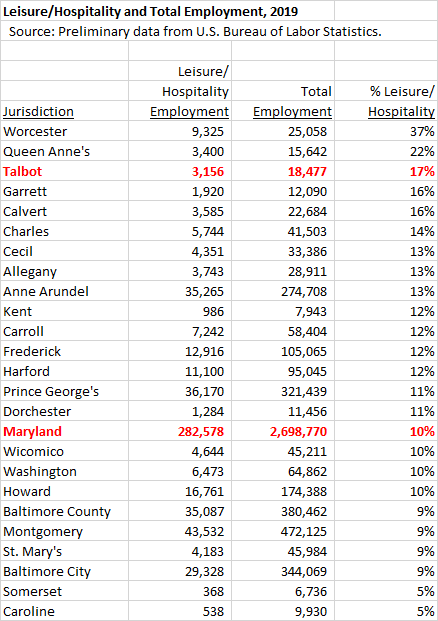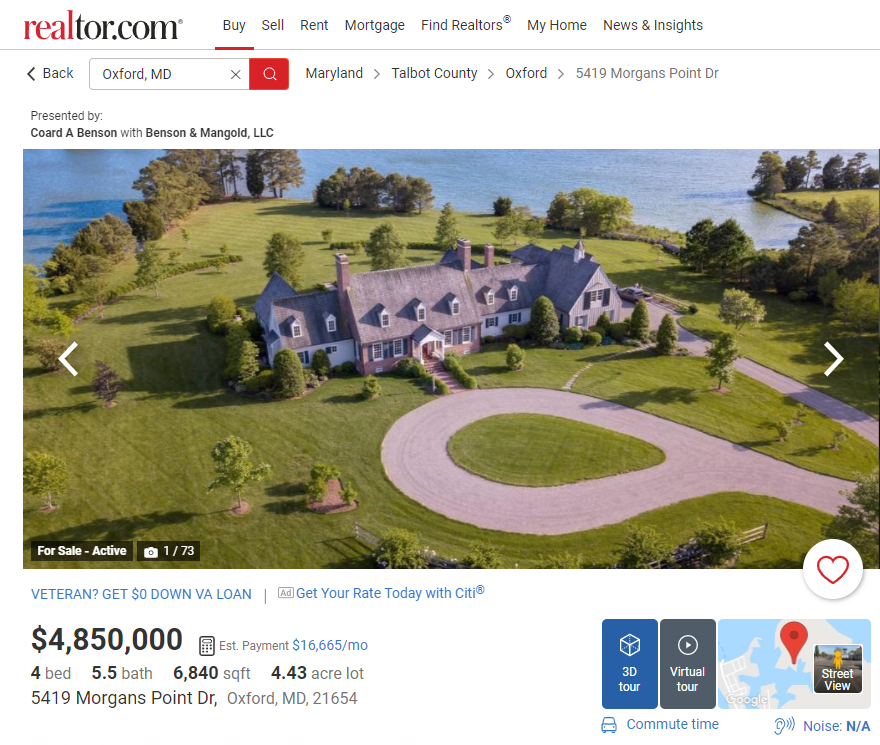By Adam Pagnucco.
Last week, the Talbot County Council voted to keep the Confederacy-memorializing Talbot Boys statue on the grounds of its county courthouse. The vote prompted a protest and charges of “systemic racism” from the county NAACP. Ominously, the vote has received coverage in media markets outside the Eastern Shore, including Washington, Baltimore, New York City, Philadelphia, Long Island and North Carolina. All of this is happening as confederate statues are coming down all over the country and nearby Wicomico County took down a confederate sign in Salisbury.
By sticking with the Confederacy over its own economy and tax base, the Talbot County Council has taken an enormous risk.
Here is why. The table below shows the percentage of total employment accounted for by the leisure and hospitality sector, defined as hotels, motels, restaurants, bars, museums, performing arts, spectator sports, recreation, gambling and related industries in 2019. This sector accounted for 10% of Maryland’s total employment that year. It accounted for 17% of Talbot County’s employment, third in the state behind Worcester County (37%) and Queen Anne’s County (22%).

This sector is extremely vulnerable to the economic crisis caused by COVID-19 and Talbot is extremely dependent on it. It would also be vulnerable to any potential boycott caused by the county leaders’ embrace of the Confederacy. If both the COVID-19 crisis and a boycott hit Talbot County at the same time, it would be an unbearable double whammy to the county’s crucial leisure and hospitality businesses. Lacking an impregnable anchor like a large military base (as Harford, St. Mary’s and Prince George’s Counties have) or a sizeable federal government presence (as Montgomery and Prince George’s Counties have), Talbot’s economy has no way to deal with a big hit on its tourism industry.
But there is more. Talbot County is not an everyday tourist destination. It offers a range of high-end amenities along with beautiful bayfront and riverfront property that attracts the wealthy, both as tourists and as full- or part-time residents. That brings sky-high property values to the county, an immense asset. Talbot County had the second-highest assessable base per capita ($231,388) in Maryland in FY20, behind only Worcester County and far surpassing the state average ($131,325). High property values enable Talbot County to have the lowest real property tax rate in the state as well as the second lowest income tax rate.

Not many places in Maryland have $5 million homes for sale like this one in Oxford.
The huge majority of counties on the East Coast would be jealous of Talbot County’s mix of high-end tourism and steep property values. But what happens if a progressive boycott is launched against the white supremacist preferences of its county leadership? The effects on the county’s tourism industry are obvious but what if property values are also affected because wealthy home purchasers choose to buy elsewhere? Commercial property values may already be at risk because of COVID-related economic losses and that is even before any potential boycott. If home price appreciation tapers off too, the county government could face very tough budget choices. Service cuts and tax increases are not unthinkable.
Because of its industry structure, Talbot County’s economy is exceedingly vulnerable to the effects of COVID-19. The county’s leaders must do everything possible to protect the golden egg that delivers its prosperity – its leisure and hospitality sector. Instead, the county council’s loyalty to the Confederacy has greatly increased the county’s economic peril by risking an anti-racism boycott. Talbot County residents and businesses could pay the ultimate price.
